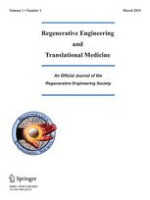
CELL AND TISSUE RESEARCH
Scope & Guideline
Empowering Scientists with Essential Knowledge in Cell and Tissue Studies
Introduction
Aims and Scopes
- Cellular Mechanisms and Signaling:
Research on the molecular pathways and cellular mechanisms that govern cell function, differentiation, and responses to stimuli. This includes studies on signaling pathways, gene expression, and the role of various proteins in cellular processes. - Tissue Regeneration and Repair:
Focuses on the biological processes involved in tissue repair and regeneration, including the role of stem cells, extracellular matrix interactions, and regenerative medicine approaches. - Comparative Biology and Evolution:
Investigates cellular and tissue structures across various species to understand evolutionary adaptations and functional similarities, often employing model organisms for comparative studies. - Neurobiology and Neurodegeneration:
Examines the cellular and molecular basis of neurobiology, including neuronal differentiation, neurodegeneration, and the role of glial cells in neural health and disease. - Histology and Ultrastructure:
Involves detailed histological and ultrastructural studies to elucidate the organization and function of cells and tissues, contributing to a deeper understanding of their physiological roles. - Stem Cell Research and Therapeutics:
Explores the potential of stem cells in regenerative medicine, including their differentiation, therapeutic applications, and challenges in clinical settings.
Trending and Emerging
- Regenerative Medicine and Stem Cell Therapy:
Research focused on the therapeutic applications of stem cells and regenerative medicine is significantly increasing, highlighting the potential for cell-based therapies in treating various diseases and injuries. - Microenvironment and Extracellular Matrix Interactions:
Emerging studies emphasize the importance of the cellular microenvironment and extracellular matrix in regulating cell behavior, with a focus on how these interactions influence tissue repair and regeneration. - Neuroinflammation and Neurodegeneration:
There is a growing interest in understanding the roles of neuroinflammation and cellular interactions in neurodegenerative diseases, reflecting an increased focus on the neurobiology of aging and injury. - Applications of Advanced Imaging Techniques:
The integration of advanced imaging techniques, including high-resolution microscopy and 3D imaging, is on the rise, providing deeper insights into cellular structures and dynamics. - Functional Genomics and Proteomics:
Research utilizing functional genomics and proteomics to explore cellular functions and interactions at a systems biology level is becoming more prevalent, offering a comprehensive understanding of complex biological processes.
Declining or Waning
- Traditional Histopathology:
There is a noticeable decrease in publications focusing solely on traditional histopathological techniques without the integration of modern molecular or imaging technologies, as the field shifts towards more advanced methodologies. - Basic Cell Culture Studies:
Research that primarily utilizes basic cell culture without exploring more complex models such as 3D cultures or organoids is becoming less common, as there is a growing emphasis on more physiologically relevant systems. - Invertebrate Model Research:
The use of invertebrate models, while still relevant, is experiencing a decline as research increasingly focuses on mammalian and human systems that may yield more directly applicable insights for clinical research. - Tissue Engineering Without Functional Outcomes:
The focus on tissue engineering studies that do not assess functional outcomes or integration into biological systems is diminishing, reflecting a shift towards studies that emphasize the functional implications of engineered tissues.
Similar Journals

Organogenesis
Unveiling the Complexities of Organogenesis.Organogenesis is a leading journal published by Taylor & Francis Inc, dedicated to advancing the field of developmental biology and regenerative medicine. With an ISSN of 1547-6278 and E-ISSN 1555-8592, this journal spans an extensive research scope that includes embryology, transplantation, and biomedical engineering, distinguishing itself as a crucial platform for researchers and practitioners alike. Its impact is reflected in its performance across various categories in 2023, earning Q3 rankings in Biomedical Engineering and Embryology, Q4 in Developmental Biology, and Q2 in Transplantation, showcasing its reputable standing among peer journals. Moreover, with Scopus rankings indicating strong positioning in the fields of medicine and biochemistry, Organogenesis is essential for those looking to publish or stay updated on pioneering research. The journal facilitates rigorous peer-review and offers a forum for disseminating innovative findings, making it an invaluable resource for academics, professionals, and students committed to understanding the complexities of organism development.

Cell Regeneration
Pioneering Insights into Cellular RenewalCell Regeneration, published by SPRINGERNATURE, stands at the forefront of biological research, focusing on the dynamic field of cellular development and regenerative biology. Since its establishment in 2012, this journal has embraced an Open Access model, facilitating widespread dissemination of key findings and fostering collaboration among researchers in the Netherlands and beyond. With an impact factor underscoring its significance, Cell Regeneration is positioned in the Q2 category in both Cell Biology and Developmental Biology as of 2023, ranked #32 out of 82 and #170 out of 285 in relevant Scopus peer fields. The journal encompasses a broad spectrum of research that advances our understanding of cellular processes, offering vital insights into regenerative mechanisms and their applications in therapies. This robust platform not only serves as a valuable resource for researchers, professionals, and students but also encourages scholarly dialogue and innovation in the fast-evolving landscape of cell biology.

TRENDS IN CELL BIOLOGY
Shaping the Future of Cell Biology ResearchTRENDS IN CELL BIOLOGY, published by CELL PRESS, is a premier journal in the field of cell biology, recognized for its high-impact contributions since its inception in 1991. As a distinguished member of the Q1 quartile within its category, the journal holds an impressive Scopus ranking of #8 out of 285, placing it in the 97th percentile of the field, which underscores its reputation for excellence. The journal serves as an essential resource for researchers, professionals, and students who are engaged with groundbreaking advancements in biochemistry, genetics, and molecular biology. Although it is not open access, it provides critical insights into the latest trends, reviews, and advancements in cell biology, making it a crucial tool for anyone committed to understanding the complexities of cellular systems. With a focus on innovative and transformative research, TRENDS IN CELL BIOLOGY continues to shape the discourse in cell biology and enhance the scientific community's knowledge.

Adipocyte
Pioneering Research in Cell and HistologyAdipocyte is a distinguished academic journal published by Taylor & Francis Inc., focusing on groundbreaking research within the realms of cell biology and histology. With an impact factor that reflects its importance, the journal has achieved a Q2 ranking in Cell Biology and a prestigious Q1 ranking in Histology for 2023, cementing its reputation as a leading resource for scientists and researchers in these fields. Since transitioning to Open Access in 2019, Adipocyte has fostered a wider dissemination of knowledge, enabling unrestricted access to a wealth of studies and reviews critical for advancing the understanding of adipose tissue biology. Located in the United Kingdom, with converged years spanning from 2013 to 2024, the journal serves as an essential platform for the exchange of innovative ideas and findings, supporting the academic community's efforts to unravel the complexities related to fat cells and their implications in health and disease.

BIOCELL
Advancing the Frontiers of Cell BiologyBIOCELL is a distinguished peer-reviewed journal dedicated to the field of Cell Biology, published by TECH SCIENCE PRESS. Since its inception in 1995, the journal has been at the forefront of disseminating innovative research, with converged publication years extending from 1995 to 2013 and from 2015 to 2024. Although it currently holds a Q4 ranking in the Cell Biology category according to the 2023 category quartiles, BIOCELL aims to foster advancements by providing a platform for researchers, professionals, and students to share their findings in biochemistry, genetics, and molecular biology. The journal is available in both print (ISSN: 0327-9545) and digital formats (E-ISSN: 1667-5746) and seeks to attract contributions that enhance scholarly dialogue and understandings of cellular mechanisms and innovations. With a commitment to quality research and critical discourse, BIOCELL plays an important role in nurturing the scientific community within Argentina and beyond, offering vital insights that contribute to the advancement of the life sciences.

CYTOTECHNOLOGY
Cultivating Discovery: Inspiring New Horizons in Bioengineering and Biotechnology.CYTOTECHNOLOGY, an esteemed journal published by Springer, stands as a vital resource in the fields of Bioengineering, Biomedical Engineering, and Biotechnology. With an impact factor reflective of its solid position within academia, this journal encompasses a broad scope dedicated to the advancement of cytotechnological research and applications from its inception in 1987 through to its latest volumes in 2024. Based in the Netherlands, it is committed to providing researchers, professionals, and students with high-quality, peer-reviewed articles that contribute to the understanding and innovations in cytotechnology. Although currently not open access, CYTOTECHNOLOGY has garnered a commendable reputation, holding Q3 rankings in multiple categories, indicating its relevance and influence within the scientific community. Researchers are encouraged to submit their cutting-edge findings to share insights that can spark further advancements in this dynamic field.

MOLECULAR AND CELLULAR BIOLOGY
Driving Innovation in Molecular and Cellular ScienceMOLECULAR AND CELLULAR BIOLOGY, published by TAYLOR & FRANCIS INC, stands as a preeminent platform for researchers, professionals, and students engaged in the dynamic field of molecular and cellular biology. Established in 1981 and ongoing into 2024, the journal features cutting-edge research that spans across vital sub-disciplines, garnering a strong impact in its contributions to the scientific community. With an impressive Q2 ranking in Cell Biology and Q1 ranking in Molecular Biology for 2023, it consistently publishes high-quality articles that reflect the latest advancements and discoveries within the field. The journal is particularly well-regarded for its rigorous peer-review process and commitment to scientific excellence, making it an invaluable resource for those seeking to deepen their understanding of molecular mechanisms and cellular processes. Although not open access, the journal offers diverse access options for researchers to reach the latest findings. By maintaining a strong focus on biochemistry, genetics, and molecular biology, MOLECULAR AND CELLULAR BIOLOGY remains essential reading for anyone looking to contribute to or stay informed about significant developments within this pivotal area of study.

Frontiers in Cell and Developmental Biology
Fostering collaboration for groundbreaking biological discoveries.Frontiers in Cell and Developmental Biology is a leading open-access journal published by FRONTIERS MEDIA SA, dedicated to advancing the understanding of fundamental biological processes at the cellular and developmental levels. Since its inception in 2013, the journal has positioned itself as a cornerstone of research in its field, achieving esteemed Q1 quartile rankings in both Cell Biology and Developmental Biology for 2023. With a robust Scopus ranking of #13 out of 82 in Developmental Biology and #67 out of 285 in Cell Biology, it represents a vital platform for innovative research and scholarly discourse. The journal provides a comprehensive and accessible avenue for researchers, professionals, and students alike to share high-quality findings and insights into cellular mechanisms and developmental processes, fostering collaboration and knowledge exchange in the global scientific community. Based in Lausanne, Switzerland, Frontiers in Cell and Developmental Biology is committed to open science, ensuring that all articles are freely accessible to the public, thereby broadening the impact of research in the biological sciences.

NATURE REVIEWS MOLECULAR CELL BIOLOGY
Advancing the frontiers of molecular and cell biology.NATURE REVIEWS MOLECULAR CELL BIOLOGY, published by NATURE PORTFOLIO, stands as a seminal journal in the fields of cell and molecular biology, with a significant impact factor that underscores its influence and reputation within the scientific community. Established in 2000 and continuing its legacy into 2024, this journal delivers comprehensive reviews that synthesize current knowledge and advancements in molecular and cellular processes. Respected for its high-quality articles, it has maintained a prestigious Q1 ranking in both Cell Biology and Molecular Biology categories as of 2023. With an exceptional Scopus ranking, taking the top position in its category, it attracts a readership of prominent researchers, professionals, and students eager to stay abreast of groundbreaking discoveries and methodologies. Although it does not offer Open Access, subscribers benefit from exclusive access to vital insights that foster innovative research approaches and advancements in the life sciences. The journal’s objective is to bridge the gap between research and application, providing indispensable resources to its audience while contributing to the global conversation on molecular and cellular biology.

Regenerative Engineering and Translational Medicine
Driving Innovation at the Intersection of Science and HealthRegenerative Engineering and Translational Medicine is an esteemed academic journal published by Springer Heidelberg, focusing on the interdisciplinary fields of biomaterials, biomedical engineering, and cell biology. With an ISSN of 2364-4133 and an E-ISSN of 2364-4141, the journal has carved a niche for itself since its inception in 2015, showcasing cutting-edge research that bridges the gap between scientific findings and practical applications in regenerative medicine. As a recognized platform in its field, it is currently positioned within Q3 quartiles in biomaterials, biomedical engineering, and medicine (miscellaneous), with a Scopus ranking that reflects its growing influence among peers. The journal aims to disseminate high-quality, peer-reviewed articles that highlight advancements in regenerative engineering, further advancing both theoretical and applied research. Scholars and practitioners seeking to stay at the forefront of the ever-evolving landscape of regenerative health solutions will find invaluable insights and innovations within these pages. Join a community of leading thinkers and explore the journal's comprehensive research contributions, which are crucial for fostering partnerships between academia and industry in the quest for transformative medical solutions.